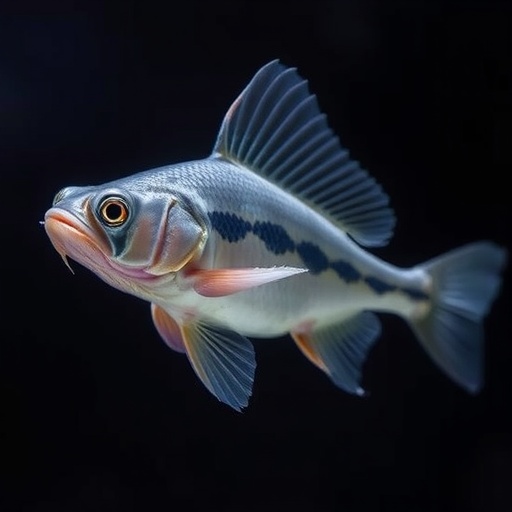In an enlightening study published in BMC Genomics, researchers delve into the intricate mechanisms of spermatogenesis, hormonal dynamics, and the modulation of testicular gene expression in male blue catfish, Ictalurus furcatus. Conducted by a team led by K.A. Martin, this research sheds light on pivotal stages of development ranging from puberty to early adulthood in this aquatic species. Given its importance in both ecological and aquacultural contexts, understanding these biological processes could hold significant implications for fisheries management and conservation efforts.
The blue catfish, a species native to North America, serves as an excellent model for examining the hormonal and genetic underpinnings of male reproductive biology. This research provides an opportunity to explore how external factors such as water temperature, nutrition, and social interactions can influence reproductive health. Through their comprehensive study, the authors employed cutting-edge genomic technologies to analyze how various hormonal fluctuations impact the expression of specific genes associated with spermatogenesis.
During pubescent development, male blue catfish experience a surge in reproductive hormones, which are critical for initiating spermatogenesis. The study meticulously charts the timeline of these hormonal changes, noting the peaks in testosterone levels that coincide with significant alterations in testicular gene expression profiles. This relationship is crucial not only for understanding male reproductive health in fish but also for broader implications in other vertebrate species, including humans.
Moreover, the research identifies specific genes that are upregulated or downregulated during pivotal developmental phases. This gene expression analysis reveals a fascinating orchestration of molecular events that facilitate the maturation of spermatozoa. Insights gained from this can deepen our understanding of reproductive physiology and may lead to advancements in aquaculture. For example, by manipulating these hormonal pathways, fish farmers could potentially enhance breeding programs, leading to better yields and more resilient populations.
Interestingly, the study does not limit its focus to a single hormonal pathway. Rather, it explores the interaction between various hormones, such as cortisol and insulin-like growth factor, which also play substantial roles in regulating spermatogenesis. Understanding these complex interactions is vital for creating a holistic picture of how male reproductive systems function under different environmental conditions.
The findings also underscore the significance of testing various environmental parameters that can affect reproductive success. In their analysis, the researchers highlight the potential impacts of climate change, including temperature fluctuations and habitat degradation, on the reproductive health of blue catfish populations. Such insights are crucial for formulating strategies to mitigate these effects and ensure the longevity of this species in its natural habitats.
Another key aspect of the study is its potential to guide future research. The authors suggest that the foundational knowledge established through their exploration of testicular gene expression and hormonal regulation lays the groundwork for subsequent investigations. Future studies could expand to examine the long-term effects of environmental stressors on reproductive strategies not just in blue catfish, but across other fish species as well, further broadening the ecological relevance of their work.
In a broader context, this research aligns with global efforts to understand biodiversity and conservation. With many fish species facing threats from overfishing and habitat loss, the implications of the findings extend far beyond laboratory settings. Conservationists can utilize this information to develop better management practices that ensure the survival and health of not just blue catfish, but also the ecosystems they inhabit.
The integration of genomics and hormonal studies offers a robust framework for future research. As scientists continue to unravel the complexities of reproductive biology, they can harness advancements in technology to further probe into gene function and regulation. This ongoing quest not only satisfies scientific curiosity but also contributes to the urgent need for sustainable practices in aquaculture and fisheries management.
Furthermore, the collaborative approach exemplified in this study—bringing together experts in genomics, biology, and environmental science—demonstrates the importance of interdisciplinary research. Tackling complex biological questions often requires a confluence of expertise, and the success of this research showcases how such collaborations can lead to groundbreaking discoveries.
As we look forward, the potential applications of this research become increasingly apparent. The pathway towards enhanced fish breeding programs, improved understanding of reproductive health in aquatic species, and environmental conservation strategies can all benefit from the insights provided in this groundbreaking study. The balancing act between development and conservation is delicate, and research like this paves the way for informed decision-making.
Overall, the revelations presented in this work enrich our understanding of not just the blue catfish, but also the intricate dance between genetics, environment, and reproduction in vertebrates. With its implications spanning across various disciplines, this study encourages further exploration of the natural world and invites us to deepen our engagement with science.
In conclusion, the intricate interplay of hormonal regulation and gene expression during sperm production in male blue catfish underscores the complexity of reproductive biology. This research not only sets the stage for future studies but also emphasizes the importance of sustaining aquatic ecosystems amidst growing human impacts.
Subject of Research: Spermatogenesis, hormonal fluctuations, and testicular gene expression in male blue catfish.
Article Title: Spermatogenesis, hormonal fluctuations, and testicular gene expression changes in male blue catfish, Ictalurus furcatus, throughout pubescent and early adult stages of development.
Article References:
Martin, K.A., Bosworth, B.G., Liyanage, S.S. et al. Spermatogenesis, hormonal fluctuations, and testicular gene expression changes in male blue catfish, Ictalurus furcatus, throughout pubescent and early adult stages of development.
BMC Genomics (2025). https://doi.org/10.1186/s12864-025-12293-3
Image Credits: AI Generated
DOI: 10.1186/s12864-025-12293-3
Keywords: Spermatogenesis, blue catfish, hormonal regulation, gene expression, Ictalurus furcatus, aquaculture, reproductive biology, conservation.




